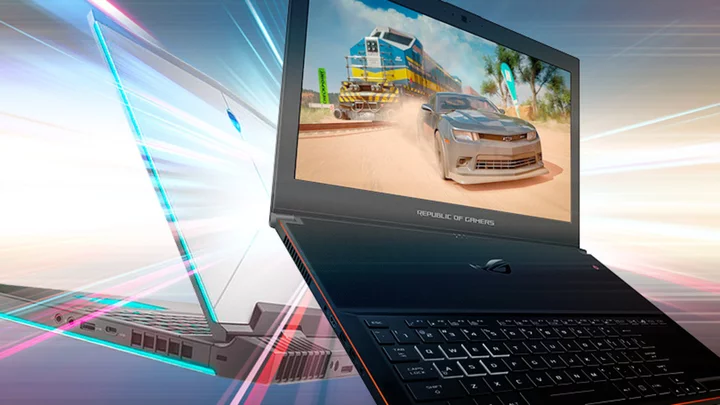You're here because you want the fastest laptop computer your money can buy. That's a challenging goal: It depends on how you define "fast," and to some extent on how you define "laptop," too.
There are different kinds of speed when talking about laptop performance, some of them intertwined and some not. And it pays to know what kind you need so you don't overspend. We all know of many different use cases across varying types of laptops, and speed does not always mean the same thing in one as in another. Below, we've detailed our picks for the fastest laptops for 2023 in different categories. Check 'em out, then read on for our buyer's guide full of advice on what to look out for when shopping for laptops based on performance.
The idea of speed in a laptop can be sliced a bunch of ways, but in practical terms, you can look at it in terms of (1) CPU processing power and (2) graphical prowess for tasks such as PC gaming, 3D rendering, or graphics-accelerated content creation. The two are very different things, and we benchmark-test all of the systems that we review with both kinds of speed in mind.
Some laptops are strong in one area and not the other. For example, it's possible to have a notebook with a top-end processor packing lots of cores and threads but paired with a minimal graphics solution. (Perhaps that is just the processor's integrated graphics silicon, historically no match for a discrete graphics chip.) A laptop like this would net you great performance on programs and workloads that take advantage of lots of CPU resources, but little in the way of power for gaming or applications that rely on graphics acceleration.
(Credit: Molly Flores)Likewise, having a dedicated graphics processor, the beefier the better, is the key to speed in games. Most of the time, CPU speed will contribute to the gaming equation insofar as it isn't a limiter or bottleneck for the graphics chip.
Now, the prescription for either need—speed for raw processing, or speed for graphics—is to pack in as potent a main processor or graphics processing unit (GPU) as you can. But when you do that, it illustrates the interplay of three key factors in laptop design: cost, power consumption, and thermals.
Higher-powered CPUs or GPUs on a given platform tend to (1) cost more, (2) require more electricity when fully engaged, and (3) run hotter when taxed to the max. That's why buffed-up gaming laptops or high-powered mobile workstations tend to be thick, heavy, expensive beasts. Their high-end chips not only cost more, but they require more space and weighty thermal hardware to keep cool.
The best of all possible worlds—maximum graphics and CPU power, maximum battery life, and thin, light design—is a goal ever out of reach. Rather, laptop design is always a trade-off of these factors, where it's not possible to twist all three of these knobs to 10.
Which CPU Type Is Best for a Laptop?
The fastest laptops, from a raw-CPU perspective, tend to fall into four classes. The first is made up of business machines with top-end processors but integrated graphics. You'll find them under top vendors' business brands, such as Latitude for Dell, ThinkPad for Lenovo, and EliteBook for HP.
Secondly are the high-end gaming laptops that pair a powerful mobile GPU, chosen to blaze through the latest games at a level appropriate for the laptop's screen, with a CPU that is at least sufficient not to hamper the graphics chip. (That malady, when it affects a PC game, is often dubbed being "CPU-limited.")
Third are mobile workstations, productivity-minded laptops designed for professional content creation and data analysis and often optimized for the specific advanced applications they use. (This is often referred to in workstation marketing lingo as an independent software vendor or ISV certification; these laptops cost their premium, in part, because of it.) You can identify these machines either by brand, such as HP's ZBook and Dell's Precision, or by the Nvidia RTX A series (formerly, Quadro) GPUs they carry.
Finally, some notebooks, such as the Gigabyte Aero 16 OLED (2023) and the Asus ProArt Studiobook 16 OLED, target creative pros such as video editors and game designers. They overlap with mobile workstations but lack those systems' ISV certifications for specialized apps. (They may feature Nvidia GeForce RTX rather than RTX A-series/Quadro GPUs, for instance.) Both high-speed and stunning high-resolution screens are featured here.
(Credit: Molly Flores)Most Intel CPU names end in a capital letter or two, which tells you a bunch about their identities. Any Core chip ending with an "H" is a maximum-power mobile chip, with many threads that your software can tap via a feature known as Hyper-Threading. Not all CPUs support Hyper-Threading, but if the programs you run are fully multi-threaded (that is, able to take advantage of all available computing threads when performing demanding tasks), this will be a big plus.
In business laptops, you'll tend to see the H-series chips only in weighty models meant for heavy calculation work or data analysis. However, you'll see the H-series in almost all gaming laptops, and in many mobile workstations. Some high-end workstation laptops make use of Intel's Xeon processors, which are at heart server chips specially designed for the demands of accelerating specialized advanced-calculation and content-creation programs, as well as for running all-out for extended periods of time. But a Core i7 or Core i9 H-series is more common, and definitely the sign of a legitimately high-end configuration.
CPUs ending in "U" or "G3," "G5," or "G7," on the other hand, signify an ultramobile processor. These are lower-power chips designed to work in slimmer, lighter laptops that have limited thermal headroom. Now, depending on what you do with your laptop, these can be perfectly fine CPUs. You'll be able to do everyday business or office tasks on a Core i5 or Core i7 of this kind with no complaints, and on the best of them, demanding content-creation tasks will be possible without painful delays. Just know that the H-series is where the real muscle is in laptop land.
(Credit: Charles Jefferies)Also, starting with its 12th Gen Core CPUs, Intel recently introduced a new "P" class of laptop processors, which fall between the U and H classes. These are for mainstream performance systems and employ the company's hybrid architecture, with high-performance and efficiency-minded cores (P-cores and E-cores) co-existing in the same chip. Intel's latest generation is 13th Gen "Raptor Lake." These chips use this same structure to blisteringly fast effect. For much more about the nuances of laptop CPUs, see our deep-dive article on how to choose the best laptop processor.
What about Intel's rival, AMD? The company's Ryzen and Ryzen Pro mobile processors have historically tilted more toward office apps and moderate gaming (with integrated graphics that often top Intel's) than the full-tilt gaming and workstation prowess of the best separate CPU and GPU combinations. But the Ryzen 4000 series mobile CPUs that debuted in 2020 changed that in a big way.
AMD's subsequent Ryzen 5000 and Ryzen 6000 mobile processors can slug it out with Intel's best, and are used in many creative and professional laptops from 2022 and 2023. AMD launched its newest line, Ryzen 7000, at the start of this year, and it has pulled AMD level with (or even ahead) of Intel's 13th Gen based on our first testing of the AMD Ryzen 9 7945HX. These chips will continue to roll out in more systems through the year.
Finally, we come to Apple's MacBooks, where the above Intel and AMD information no longer applies. In 2020, Apple began using its own silicon in its laptops rather than Intel processors. The most recent MacBook Air and 13-inch MacBook Pro utilize the latest M2 processor, the second generation of Apple's homegrown CPUs. In our testing of these systems (and the original M1 chips), we found them to be fast and impressive.
(Credit: Molly Flores)In a way, Apple's switch to its own processors takes the decision out of your hands, because you're choosing within a much smaller band of CPUs. Apple's chips do have some variation: the M1 Pro and M1 Max are boosted versions of the M1 base chip, and that proved true again with 2023's M2 Pro and M2 Max. The real decision is whether to stick with a Windows system and the processor options above if you're already in that ecosystem, or jump over to macOS.
Understanding Laptop Graphics Performance: Power for Play and Content Creation
If the kind of speed you are after is for PC gaming, what you need is a laptop with a dedicated graphics chip, or GPU. Most of the leading-edge gaming laptops these days use various flavors of Nvidia's GeForce mobile chips, with the RTX 30 series (model numbers in the 3000s) now being pushed aside by the RTX 40 series (model numbers in the 4000s) in the latest models. You'll see both kinds still on the market.
If your laptop has a 1080p (1,920-by-1,080-pixel) display, then a GeForce RTX 3050/4050 or higher chip will generally suffice if you play modern games at high settings. The RTX 3070 or RTX 4070 are usually a fitting match for a resolution of 2,560 by 1,440 pixels and below, while a GeForce RTX 3080 Ti, 4080, or 4090 will be overkill for 1080p but the best starting point for gaming on a 4K (3,840-by-2,160-pixel) screen. Nvidia's latest GeForce RTX 40 Series chips can help make 4K gaming and fancy ray-traced lighting smoother than ever thanks in part to the DLSS rendering technology, where you can apply it in compatible games.
(Credit: Molly Flores)If you'll use your gaming laptop with an external monitor or monitors that have a higher resolution than the laptop's built-in screen, you might consider a GPU that's several steps ahead of the laptop's own screen. Otherwise, you'll want to match the performance of the GPU with the upper limits of the laptop's own panel.
One wrinkle to all of this is the emergence of high-refresh-rate displays in laptops. A typical 60Hz laptop display (which redraws the screen 60 times per second) won't show much benefit from frame rates in excess of 60 frames per second (fps). If your high-powered GPU can churn in a given game at a consistent 100fps, you won't see much added smoothness. However, all of the latest gaming laptops now ship with high-refresh panels capable of rewriting at 120Hz, 144Hz, 165Hz, 240Hz, or even as high as 300Hz. These screens can make use of those extra frames for smoother gameplay and can justify a high-powered GPU paired with a 1080p screen. (For more on the topic, see our explainer Does Your Gaming Laptop Need a High-Refresh-Rate Screen?)
(Credit: Joseph Maldonado)On a related note, laptops with screens that support Nvidia's G-Sync technology are worth looking out for. In these, the screen rewrites at the same rate that the GPU churns out frames, in essence adjusting the refresh rate dynamically. This reduces screen artifacts and "tearing" (in which parts of the screen misalign for a beat as they are rendered). With a high-refresh screen, a top-notch GPU will be better leveraged; with G-Sync, a marginal one will be enhanced.
Another factor, if you're shopping for a maxed-out laptop, is virtual reality compatibility. You'll want to look for a model with a GeForce GTX 1660 Ti or higher GPU if you mean to run a virtual reality headset. It's best to opt for the right GPU now if you might want to explore VR later, as you can't upgrade the GPU after the fact. (See our guide to the best laptops for VR.) The recent RTX line should suffice for VR as well, from the RTX 3050 and 4050 on up.
Does Storage or Memory Make a Computer Faster?
Assessing storage speed is more straightforward than weighing CPUs or GPUs. The storage solutions in today's laptops fall into three classes: hard drives, SATA solid-state drives (SSDs), and PCI Express SSDs. That sequence is a fair summary of their relative speed (slowest, faster, fastest) and their relative cost (least to most expensive, in terms of cost per gigabyte).
These days, the fastest laptops all use PCI Express SSDs, and indeed, this class of drive is taking over the field. These are either implemented as M.2 drives (see our guide to the best M.2 solid-state drives) or soldered down to the motherboard, and top out in most configurations at 1TB or 2TB. PCI Express describes the bus pathway that your data takes when using these drives, and it is often associated today with the term "NVMe," a protocol for making the most of PCI Express drives' speeds. Both are good buzzwords to look out for. The alternative to a PCI Express SSD is Serial ATA or SATA, which is perfectly serviceable in an SSD but is yesterday's interface. Often, a laptop vendor won't differentiate between the two. SATA as it relates to SSDs is fading out of relevance in new systems, nowadays.
(Credit: Molly Flores)If you're looking to maximize real and perceived speed in a laptop, the boot drive should be an SSD, preferably a PCI Express/NVMe one. SATA is still relevant for hard drives, though; if the laptop has a hard drive, it should be implemented as a secondary drive used for bulk storage. You're more likely to see such dual-drive arrangements in larger laptops.
As for assessing the RAM in the system, it's an exercise in making sure you get enough for your typical tasks without overpaying or underestimating. 8GB is the barest minimum we'd settle for in a powerful laptop, with 16GB a much better baseline. Getting even more can make sense if you make use of RAM-hogging content-creation apps like Adobe Photoshop or Premiere Pro. If you're outfitting a tricked-out gaming laptop, 16GB ought to do.
Which Are the Fastest Laptops to Buy?
The laptops below in our detailed spec breakout chart are very good places to start looking if absolute speed is a key concern for you. We looked at Cinebench and HandBrake benchmark scores for a measure of raw CPU speed and multithreaded power; these tests tax a CPU to its limits on all cores and threads. We also checked out 3DMark scores for a measure of graphics processing capability, and PCMark 10 results for office productivity and overall system performance. (Click through to the actual reviews linked below for details and much more performance talk.)
Use these as launching points for your laptop search. Remember, many of these models can be bought in lesser or brawnier configurations, so the limit tends to be how much money you have, and how much hardware a laptop maker can stuff in the chassis size of your choice, within thermal and practical limits.
You'll also find more speedy, powerful choices in our roundups of the best gaming laptops and the best mobile workstations. Other top performers can be found in our roundups of the best ultraportables and the top 2-in-1 convertible laptops.









